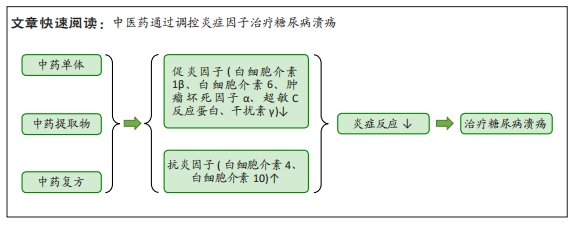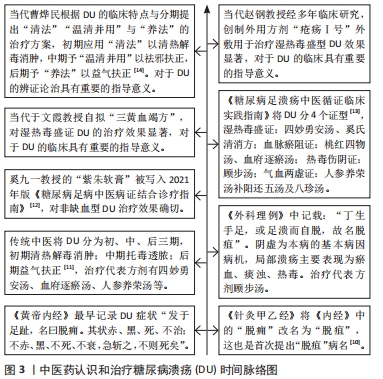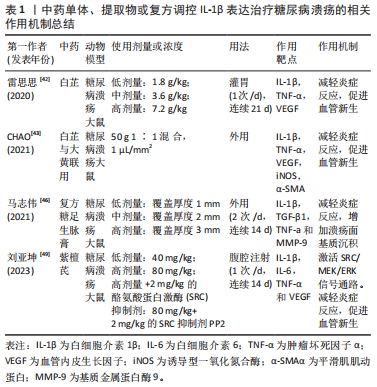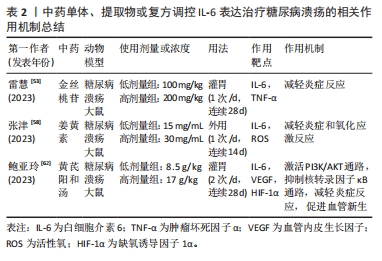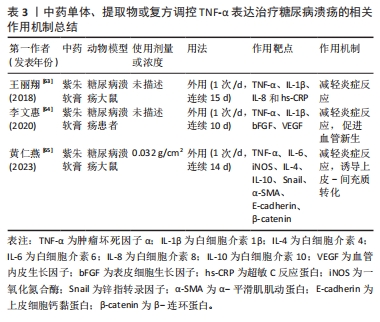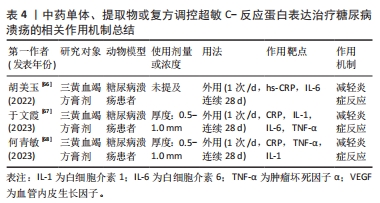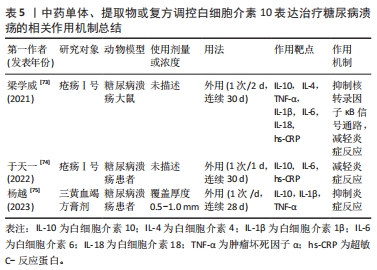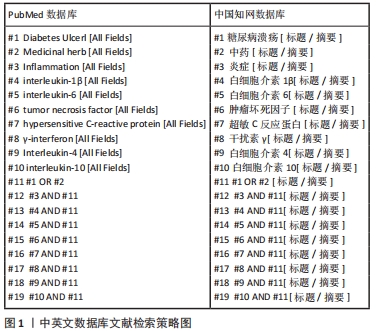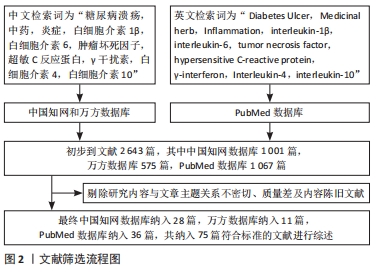[1] NATHAN DM. Long-term complications of diabetes mellitus. N Engl J Med. 1993; 328(23):1676-1685.
[2] MELONI M, IZZO V, GIURATO L, et al. Prevalence, clinical aspects and outcomes in a large cohort of persons with diabetic foot disease: comparison between neuropathic and ischemic ulcers. J Clin Med. 2020;9(6):1780.
[3] SHOFLER D, RAI V, MANSAGER S, et al. Impact of resolvin mediators in the immunopathology of diabetes and wound healing. Expert Rev Clin Immunol. 2021;17(6):681-690.
[4] BUEGESS JL, WYANT WA, ABDO AB, et al. Diabetic wound-healing science. Medicina. 2021;57(10):1072.
[5] JIAO Y, CHEN Xl, NIU YX, et al. Wharton’s jelly mesenchymal stem cells embedded in PF-127 hydrogel plus sodium ascorbyl phosphate combination promote diabetic wound healing in type 2 diabetic rat. Stem Cell Res Ther. 2021;12(1):559.
[6] 杨博华,鞠上.中西医结合防治糖尿病足中国专家共识(精简版)[J].北京中医药,2019,38(11):1078-1087.
[7] AWASTHI A, SINGH SK, KUMAR B, et al. Treatment strategies against diabetic foot ulcer: success so far and the road ahead. Curr Diabetesn Rev. 2021;17(4):421-436.
[8] 刘佳莅,姜伟华,夏成勇,等.生肌玉红膏联合封闭负压引流术对糖尿病足患者溃疡创面血管新生及氧化应激指标的影响[J].湖南中医药大学学报, 2019,39(2):257-261.
[9] 周丽俊,叶企兵,叶泽宇.中医综合疗法治疗糖尿病足溃疡的临床疗效观察[J].中华中医药杂志,2022,37(6):3613-3616.
[10] 章威.中华图书集成:第十八册[M].北京:中医古籍出版社,1999:119.
[11] 罗恩艳,杨九一,文奕舒,等.张嗣兰辨治脱疽经验[J].山东中医杂志,2023, 42(9):991-994.
[12] 陆灏,倪青,柳国斌,等.糖尿病足病中医病证结合诊疗指南[J].中医杂志, 2021,62(12):1099-1104.
[13] 王军,徐军.糖尿病足溃疡中医循证临床实践指南[J].中国中西医结合外科杂志,2015,21(5):540-543.
[14] 徐洪涛,曹烨民.曹烨民教授分期辨证治疗糖尿病足筋疽经验[J].西部中医药,2021,34(5):61-64.
[15] AITCHESON SM, FRENTIU FD, HURN SE, et al. Skin wound healing: normal macrophage function and macrophage dysfunction in diabetic woundss. Molecules. 2021;26(16):4917.
[16] WAN G, CHEN Y, CHEN J, et al. Regulation of endothelial progenitor cell functions during hyperglycemia: new therapeutic targets in diabetic wound healings. J Mol Med (Berl). 2022;100(4):485-498.
[17] MARÔNEK M, MARAFINI I, GARDLÍK R, et al. Metalloproteinases in inflammatory bowel diseasess. J Inflamm Res. 2021;14(1):1029-1041.
[18] BREM H, TOMIC-CANIC M. Cellular and molecular basis of wound healing in diabetes. J Clin invest. 2007;117(5):1219-1222.
[19] 金剑虹,洪郁芝,徐新鹏.感染性糖尿病足患者血清白细胞介素表达与感染的关系[J].中华医院感染学杂志,2015,25(4):747-749.
[20] 方金赢.炎症反应抑制对糖尿病足溃疡患者血清血管生长因子、炎症因子的影响研究[J].数理医药学杂志,2021,34(11):1700-1702.
[21] DINARELLO CA, DONATH MY, MANDRUP-POULSEN T. Role of IL-1beta in type 2 diabetes. Curr Opin Endocrinol. 2010,17(4):314-321.
[22] 肖正华,张正军,陈定宇,等.黄芪多糖对糖尿病足部溃疡成纤维细胞增殖功能的影响[J].中国糖尿病杂志,2010,18(12):913-916.
[23] MIRZA RE, FANG MM, ENNIS WJ, et al. Blocking interleukin-1beta induces a healing-associated wound macrophage phenotype and improves healing in type 2 diabetes. Diabetes. 2013;62(7):2579-2587.
[24] GMEZ-ZORRILLA S, MORANDEIRA F, CASTRO MJ, et al. Acute inflammatoryresp onse of patients with pseudomonas aeruginosa infections: a prospective study. Microb Drug Resist. 2017;23(4):523-530.
[25] 范世珍,于波海.动态监测CRP、SAA和IL-6在儿童甲型流感诊断和治疗中的价值[J].中国实验诊断学,2021,25(1):9-12.
[26] KARMAKER M, SANYAL SK, SULTANA M, et al. Association of bacteria in diabetic and non-diabetic foot infection - An investigation in patients from Bangladesh. J Infect Public Heal. 2016;9(3):267-277.
[27] ASIF M, YOUSAF HM, SALEEM M, et al. Raphanus sativus seeds oilarrested in vivo inflammation and angiogenesis through down-regulation of TNF-a. Curr Pharm Biotechnol. 2022;23(5):728-739.
[28] WNG T, HE R, ZHAO J, et al. Negative pressure wound therapy inhibits inflammation and upregulates activating transcription factor-3 and downregulates nuclear factor-κB in diabetic patients with foot ulcerations. Diabetes Metab Res Rev. 2017. doi:10.1002/dmrr.2871.
[29] JETHANI S, BHUTANI N, YADAV A. Diagnostic utility of combined immature and total neutrophil counts along with C-reactive protein in early detection of neonatal sepsis: a cross-sectional study. Ann Med Surg (Lond). 2022;77(9): 103589.
[30] SUN JT, LIU Y, LU L, et al. Diabetes-invoked high-density lipoprotein and its association with coronary artery disease in patients with type2 diabetes mellitus. Am J Cardiol. 2016;118(11):1674-1679.
[31] 余成强,王启明,何家花,等.陕西省商洛市儿童呼吸道感染病原体血清流行病学研究[J].现代检验医学杂志,2019,34(6):142-144.
[32] 陈向红,何红梅,赵娜,等.糖尿病足感染病原菌分布及多重耐药菌感染相关因素分析[J].中国消毒学杂志,2023,40(10):757-759, 763.
[33] XU L, GONG C, LI G, et al. Ebselen suppresses inflammation induced by Helicobacter pylori lipopolysaccharide via the p38 mitogen-activated protein kinase signaling pathway. Mol Med Rep. 2018;17(5):6847-6851.
[34] ALTUN E, YILDIZ A, CEVIK C, et al. The role of high sensitive C-reactive protein and histopathological evaluation in chronic gastritis patients with or without Helicobacter pylori infection. Acta Cir Bras. 2019;34(3):e201900310.
[35] HAMMAD R, ELMADBOULY AA, AHMAD IH, et al. T-natural killers and interferon gamma/interleukin 4 in augmentation of infection in foot ulcer in type 2 diabetes. Diabetes metab Synbr Obes. 2021;14:1897-1908.
[36] 谭强,肖敏,余倩颖,等.四川文氏皮外科协定方马齿苋汤加减治疗慢性湿疹疗效及对IL-4、IL-22、IFN-γ的影响[J].中国皮肤性病学杂志,2019,33(7): 824-827.
[37] SCHULTEN V, TRIPPLE V, SIDNEY J, et al. Association between specific timothy grass antigens and changes in TH1-and TH2-cell responses following specific immunotherapy. J Allergy Clin Immunol. 2014;134(5):1076-1083.
[38] ZHENG ZW, CHEN YH, WU DY, et al. Development of an accurate and proactive immunomodulatory strategy to improve bone substitute material-mediated osteogenesis and angiogenesis. Theranostics. 2018;8(19):5482-5500.
[39] 张洁,肖天骄,李丽等.白细胞介素4调控巨噬细胞极化及骨髓间充质干细胞的成骨分化[J].中国组织工程研究,2024,28(25):3960-3966.
[40] NAGATA K, NISHIYAMA C. IL-10 in mast cell-mediated immune responses:anti-inflammatory and proinflammatory roles. Int J Mol Sci. 2021;22(9):4972-4975.
[41] MOTWANI MP, GILROY DW. Macrophage development and polarization in chronic inflammation. Semin Immunol. 2015;27(4):257-266.
[42] 雷思思.白芷对2型糖尿病小鼠皮肤溃疡促愈的作用机制的研究[D].天津:天津医科大学,2020.
[43] CHAO YH, YANG WT, LI MC, et al. Angelica dahurica and Rheum officinale facilitated diabetic wound healing by elevating vascular endothelial growth factor. Am J Chin Med. 2021;49(6):1515.
[44] MISHRA M, FLAGA J, KOWLURU RA. Molecular mechanism of transcriptional regulation of matrix metalloproteinase-9 in diabetic retinopathy. J Cell Physiol. 2016;231(8):1709-1718.
[45] LOBMANN R, AMBROSCH A, SCHULTZ G, et al. Expression of matrixmetalloproteinases and their inhibitors in the wounds of diabetic and non-diabetic patients. Diabetologia. 2002;45(7):1011-1016.
[46] 马志伟,马晓蓉,张甜.复方糖足生脉膏对糖尿病大鼠创面炎症消散的影响[J].中国冶金工业医学杂志,2021,38(2):142-143.
[47] HU W, YU H, ZHOU X, et al. Topical administration of pterostilbene accelerates burn wound healing in diabetes through activation of the HIF1α signaling pathway. Burns. 2022;48(6):1452-1461.
[48] LEE JO, HWANG SH, SHEN T, et al. Enhancement of skin barrier and hydration-related molecules by protopanaxatriol in human keratinocytes. J Ginseng Res. 2021;45(2):354-360.
[49] 刘亚坤,李刚,颜娟,等.紫檀芪对糖尿病性皮肤溃疡模型大鼠创面愈合的影响及机制[J].中国药房,2023,34(16):1967-1971.
[50] 曹明明,车琳琳,朱路文.金丝桃苷药理作用及机制研究进展[J].辽宁中医药大学学报,2022,24(6):150-155.
[51] 邓九红,郑超,王声遥,等.醋酸泼尼松对糖尿病肾病模型大鼠肾功能、肾脏炎性反应及AMPK/SIRT1信号通路的影响[J].基础医学与临床,2022,42(2): 243-248.
[52] JIA W, BAI T, ZENG J, et al. Combined administration of metformin and atorvastatin attenuates diabetic cardiomyopathy by inhibiting inflammation, apoptosis, and oxidative stress in type 2 diabetic mice. Front Cell Dev Biol. 2021;9:634900.
[53] 雷慧,鲍亚玲,鲍喜静,等.金丝桃苷对糖尿病足溃疡大鼠炎症反应、创面愈合及AMPK/SIRT1信号通路的影响[J].天津医药,2023,51(11):1205-1210.
[54] FEREDOUNI N, DARROUNDI M, MOVAFFAGH J, et al. Curcumin nanofibers for the purpose of wound healing. J Cell Physiol. 2019;234(5):5537-5554.
[55] MOKHTARI M, RAZZAGHI R, MOMEN-HERAVI M. The effects of curcumin intake on wound healing and metabolic status in patients with diabetic foot ulcer: a randomized, double‐blind, placebo‐controlled trial. Phytother Res. 2021;35(4): 2099-2107.
[56] LIU X, ZHANG R, SHI H, et al. Protective effect of curcumin against ultraviolet a irradiation-induced photoaging in human dermal fibroblasts. Mol Med Rep. 2018;17(5):7227-7237.
[57] LENG QQ, LI Y, PANG XL, et al. Curcumin nanoparticles incorporated in PVA/collagen composite films promote wound healing. Drug Deliv. 2020;27(1):1676-1685.
[58] 张津,崔新刚,朱彦兆,等.姜黄素对糖尿病小鼠皮肤创面愈合的影响[J].医药导报,2024,43(2):167-174.
[59] 陈晶,刘欣欣.阳和汤的临床应用和基础研究进展[J].中华中医药学刊, 2022,40(8):10-13.
[60] 牛文晶,刘鹏,王军.基于网络药理学探讨黄芪-当归治疗糖尿病足的作用机制[J].中国中西医结合外科杂志,2022,28(2):252-257.
[61] 马艳春,段莹,胡建辉,等.黄芪治疗糖尿病及其并发症研究进展[J].中医药学报,2022,50(6):103-107.
[62] 鲍亚玲,雷慧,马君,等.黄芪阳和汤调控PI3K/AKT/NF-κB信号通路促进糖尿病足溃疡大鼠创面愈合[J/OL].天津医药,1-8[2024-01-16]. http://kns.cnki.net/kcms/detail/12.1116.R.20231019.1758.002.html.
[63] 王丽翔,李文惠,柳国斌.紫朱软膏对糖尿病非缺血型溃疡愈合及相关炎性因子的干预作用[J].四川中医,2018,36(6):69-71.
[64] 李文惠,杨晓,闫少庆,等.紫朱软膏干预糖尿病足愈合过程中细胞因子表达[J].中国老年学杂志,2020,40(6):1159-1161.
[65] 黄仁燕,王宏飞,王徐红,等.紫朱软膏对糖尿病溃疡小鼠创面炎症反应及上皮-间充质转化的影响[J].陕西中医,2023,44(12):1673-1677.
[66] 胡美玉.三黄血竭方膏剂治疗湿热毒盛证糖尿病足的临床疗效观察[D].唐山:华北理工大学,2022.
[67] 于文霞,何青敏,姚彬,等.三黄血竭方对糖尿病足患者感染创面愈合及血清炎症因子水平的影响[J].广西医学,2023,45(2):157-161.
[68] 何青敏,于文霞,王猛,等.三黄血竭方外敷治疗糖尿病足湿热毒盛证的疗效及对感染创面的影响[J].河北中医药学报,2023,38(4):43-46.
[69] 李月炜,师建平,刘钰,等.改良冲和膏对糖尿病溃疡大鼠皮肤致敏性的研究[J].广州中医药大学学报,2023,40(4):955-964.
[70] 张箐鸿,李宇宏,刘辉,等.解毒化瘀丸对非缺血性糖尿病足溃疡患者实验室指标及创面愈合情况的影响[J].河南医学研究,2023,32(14):2612-2616.
[71] 徐秀娟,严小丽.温经通络熏洗方对糖尿病足患者血糖、足背动脉血流动力学和炎症因子的影响[J]. 浙江中医杂志,2022,57(7):493-494.
[72] ALI R, KHAMIS T, ENAN G, et al. The healing capability of clove flower extract (CFE) in streptozotocin-induced (STZ induced) diabetic rat wounds infected with multidrug resistant bacteria. Molecules. 2022;27(7):2270.
[73] 梁学威,苑海刚,于天一.疮疡Ⅰ号外敷对大鼠糖尿病性溃疡的影响[J].中医药信息,2021,38(4):37-41.
[74] 于天一,梁学威,赵钢.疮疡I号外敷治疗湿热毒盛型糖尿病足部溃疡的临床观察[J].中国中西医结合外科杂志,2022,28(2):248-251.
[75] 杨越,于文霞,何青敏,等.三黄血竭方外敷治疗糖尿病足溃疡疗效研究[J].陕西中医,2023,44(12):1740-1744.
|
